| |
 Click to Enlarge
Click to Enlarge
|
Thermal Conductivity Apparatus (0795)
Specifications : Total length - approx. 35 cm. Simple apparatus to show thermal expansions in introductory physics courses. Demonstrates the different thermal conductivity of four different metal rods (brass, copper, aluminium, iron). With wooden handle. LAWS & PRINCIPLES INVESTIGATED : • Conductivity of different materials.
See Enlarge
|
|
|
|
 Click to Enlarge
Click to Enlarge
|
Convection Apparatus (0796)
Specifications : Dimensions: approx. 30 x 20 cm External diameter 15 mm.
Heat resistant borosilicate glass. Gentle heating one of the lower corners of the tube creates convection currents in the liquid. The currents are demonstrated by the addition of a small amount of potassium permanganate crystals or food colorant. LAWS & PRINCIPLES INVESTIGATED : • Convection.
See Enlarge
|
|
|
|
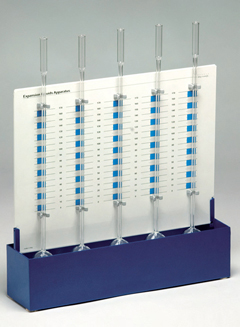 Click to Enlarge
Click to Enlarge
|
Expansion of Liquids Apparatus (0797)
Specifications : Overall dimensions: approx. 38 x 9.5 x 36 cm. Discover the relative coefficient of expansion of different liquids easily. Illustrates the different expansion of liquids and allows for the determination of the relative
coefficient of expansion. Constituted of five glass bulbs with stem, total height 400 mm; mounted against a plastic stand, with 5 scales graduated in mm. Complete with metal trough for the uniform and simultaneous heating of the 5 glass bulbs. COMPONENTS : • Stand with 5 Scales • Metal Trough • Glass Bulb with Stem (5x) • Syringe. LAWS & PRINCIPLES INVESTIGATED : • Expansion of liquids (relative expansion) • Coefficient of expansion.
See Enlarge
|
|
|
|
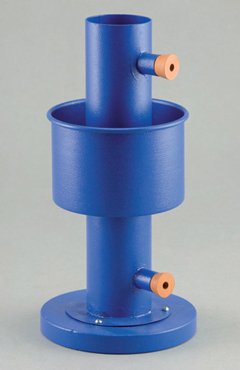 Click to Enlarge
Click to Enlarge
|
Hope’s Apparatus (0798)
Specifications : Height approx: 30 cm. Hope’s Apparatus is the simplest way to verify maximum water density at 4?C. The solid form of most substances is more dense than the liquid phase. But water plays an exception and with this apparatus you can determine the temperature at which water attains its maximum density. LAWS & PRINCIPLES INVESTIGATED : • Determination of water maximum density at 4?C • Determination of sea water density maximum at 2?C.
See Enlarge
|
|
|
|
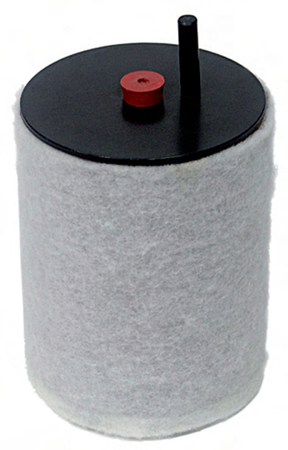 Click to Enlarge
Click to Enlarge
|
Mixing Calorimeter (0799)
Specifications : Size: 12 x 20 cm (dia. x height), Weight: approx. 250 g. Ideal apparatus for simple experiments in thermodynamics. The Mixing Calorimeter is used for the study of heat characteristics of masses. The apparatus has been insulated from the surrounding environment with a felt cover in order to perform experiments in a state of thermal equilibrium. COMPONENTS : • Copper Calorimeter, • Lid with Stirrer • Thermometer (-10 ? 110?C). LAWS & PRINCIPLES INVESTIGATED : • Determination of the water equivalent of a mixing calorimeter • Specific heat of bodies • Time constant of a thermometer.
See Enlarge
|
|
|
|
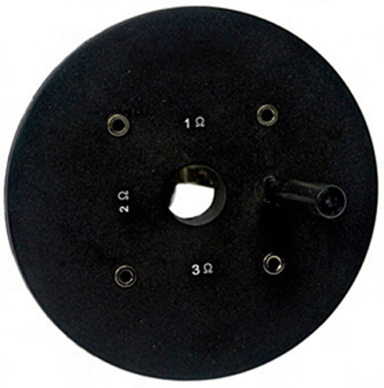 Click to Enlarge
Click to Enlarge
|
Joule’s Law Unit for Calorimeter (0800)
Specifications : Specifically developed for our Mixing Calorimeter – Resistances: 1, 2, 3 Ω 4 mm jacks for power supply. Joule’s Law: electricity and thermodynamics. The Joule’s Law Unit for Calorimeter is used to demonstrate the thermal effect of currents and the specific heat of a fluid. Add this attachment to the Calorimeter to perform experiments involving electricity and thermal energy. LAWS & PRINCIPLES INVESTIGATED : • Joule’s Law • Time dependence of the heat quantity generated in the spiral • Resistance’s value dependence of the heat quantity generated in the spiral
• Current intensity value dependence of the heat quantity generated in the spiral.
See Enlarge
|
|
|
|
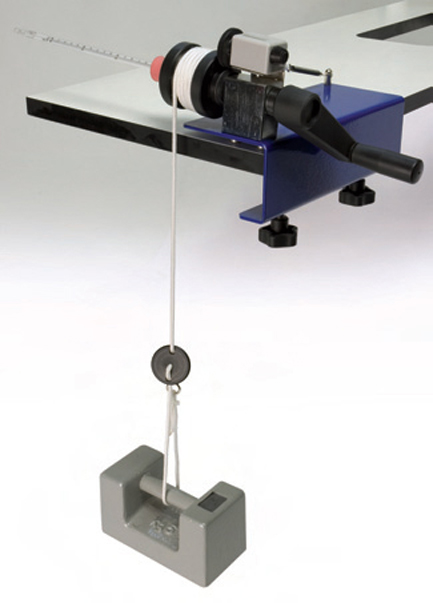 Click to Enlarge
Click to Enlarge
|
Mechanical Equivalent of Heat Apparatus (0801)
Specifications : Size: 26 x 22 x 20 cm – Inclusive of clamp for table mounting. Joule’s most important experiment, converting mechanical work to thermal energy. The apparatus is a simple and accurate demonstration of how to turn mechanical energy into heat. Using the rotation-counter and a falling mass it is possible, using a thermometer, to calculate the mechanical effect of riction
and the increase in temperature of the calorimeter. COMPONENTS : • Base • Pin with cord and spring • Weight (5 Kg) • Thermometer (-10 ? 110?C). LAWS & PRINCIPLES INVESTIGATED : • Conversion factor between joules and calories.
See Enlarge
|
|
|
|
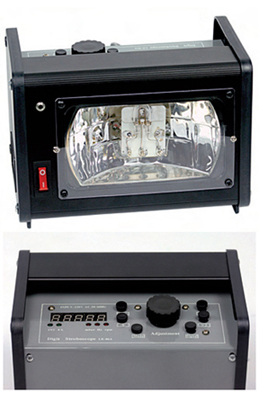 Click to Enlarge
Click to Enlarge
|
Stroboscope (0802)
Specifications : Size: 20 x 12 x 14 cm – Frequency range: 1? 300 Hz – External input for triggerLight from a timing source. A Stroboscope is a pulsed lamp which is used to observe rapidly moving phenomena, such a vibrating string or waves in a Ripple Tank. If the frequency of “flashes” from the Stroboscope matches the frequency of the object being observed, it causes the eye to see the image as having been frozen at that matched frequency. Hence, useful measurements can be made and observations made easy. LAWS & PRINCIPLES INVESTIGATED : • Frequency determination in various contexts.
See Enlarge
|
|
|
|
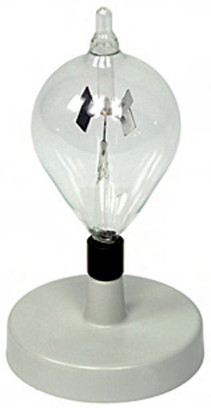 Click to Enlarge
Click to Enlarge
|
Crooke’s Radiometer (0803)
Specifications : Size: 10 x 15 cm (dia. x height) – Weight: approx. 250 g – Mounted on base. Investigating the energy and impulse of an electromagnetic wave. Invented by Sir William Crooke, the vanes in the highly effective radiometer rotate when exposed to solar radiation. The cause for this rotation can open up much debate for which students should be encouraged to develop their own explanations. Some will state that the device relies upon the difference in absorption of impulse between the black and metal vanes. Others may think there is a difference in temperature of the vanes. This device has been designed with black vanes that absorb electromagnetic radiation and reflective metal vanes. Students need also remember that black painted sides getwarmer than metallic ones. LAWS & PRINCIPLES INVESTIGATED : • Energy conversion.
See Enlarge
|
|
|
|
 Click to Enlarge
Click to Enlarge
|
Optical Bench Deluxe Edition (0804)
Specifications : Optical Bench: length 116 cm. A complete set for exploring geometrical optics. The Optical Bench Deluxe Edition allows the student to investigate a wide variety of optical phenomena. These include: reflection, lens theory, polarization, interference, diffraction and optical instruments. COMPONENTS : • Optical bench • Slider for holders (6x) • Slider for projector • Slides and diaphragm holders (2x) • Set of 7 diaphragms • Iris diaphragm • Adjustable slit diaphragm • Projector • Transformer 12 V 2.5 A • Lamp Holder Single • Lamp Holder Quadruple • Equilateral Prism • Right-angle prism (90?, 45?, 45?) • Right angle prism (90?, 60?, 30?) • Prism table • Translucent screen • Two colour metal screen • Plane mirror on mount • Double-sided concave-convex mirror • Grease spot photometer • Pair of polaroid filters • Biconvex lens f = 50 mm • Biconvex lens f = 100 mm • Biconvex lens f = 150 mm • Biconvex lens f = 200 mm • Biconvex lens f = 300 mm • Biconvex lens f = 500 mm • Biconcave lens f = 50 mm • Biconcave lens f = 100 mm • Biconcave lens f = 150 mm • Biconcave lens f = 200 mm • Biconcave lens f = 300 mm • Biconcave lens f = 500 mm. LAWS & PRINCIPLES INVESTIGATED : • Concave and convex mirror • Convergent and divergent lens
• Focal length • Gauss approximation • The eye, hyperopic and myopic eye • Inverse square law • Lens power • Luminous intensity • Magnifier and magnifying power • Photometry • Prism • Ray tracing • Refraction index • System of lenses • The compound microscope • The telescope • Thin lens equation • Principles of biconcave, biconvex lenses and mirrors • Determine the focal length of a lens • Inverse square law of light
• Rotation of light • Grease spot photometer • Polarization.
See Enlarge
|
|
|
|
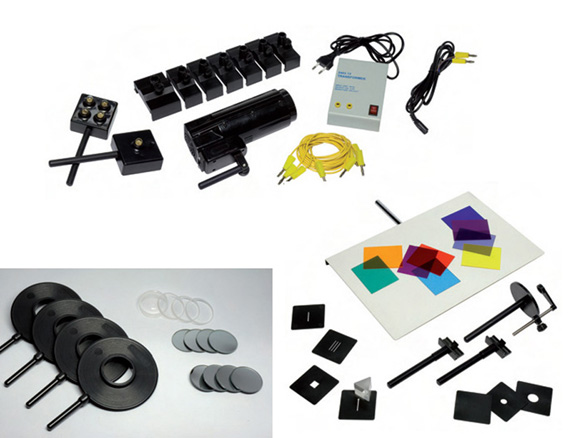 Click to Enlarge
Click to Enlarge
|
Optical Bench Standard Edition (0805)
Specifications : Optical Bench: length 116 cm. The Optical Bench Standard Edition is the most easy and complete way to begin the exploration of the optics. Simple, complete and affordable. A simple and affordable way to begin exploring optics. COMPONENTS : • Optical bench 4417.50-001
• Slider for holders (6x) • Slider for projector • Slides and diaphragm holders (2x) • Set of 7 diaphragms • Projector • Transformer 12 V 2.5 A
• Lamp Holder Single • Lamp Holder Quadruple • Equilateral Prism • Prism table • Two colour metal screen • Set of colour Filters • Halogen Lamp (spare) (2x) • Joly Photometer • Holder for Lenses and Mirrors (4x) • Set of 4 Biconvex Spherical Lenses • Set of 4 Biconcave Spherical Lenses
• Set of 4 Convex Spherical Mirrors • Set of 4 Convex Spherical Mirrors. LAWS & PRINCIPLES INVESTIGATED : • Concave and convex mirror • Convergent and divergent lens • Focal length • Gauss approximation • The eye, hyperopic and myopic eye • Inverse square law • Joly photometer • Lens power • Luminous intensity • Magnifier and magnifying power • Photometry • Prism • Refraction index • System of lenses • The compound microscope • The telescope • Thin lens equation • Principles of Bi-concave, bi-convex lenses and mirrors • Determine the focal length of a lens
See Enlarge
|
|
|
|
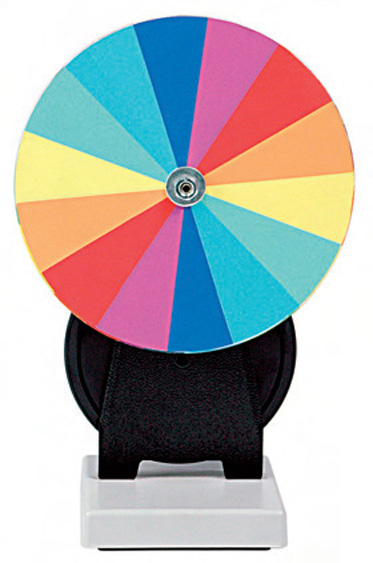 Click to Enlarge
Click to Enlarge
|
Newton’s Disk (0806)
Specifications : Size: 20 x 30 x 12 cm – Weight: approx. 1 kg – Mounted on base. The Newton’s Disk consists of an aluminium platform with coloured segments printed on it. The colours represent the primary colours of the spectrum (red, orange, yellow, green, blue, indigo and violet). When the disk is rotated, the colours blur together and the eye, unable to respond rapidly enough, sees the colours mixed together to form white. Since the eye is more sensitive to colours in the middle of the visible spectrum, the wedges with yellow and green often become narrower, while those for red and violet become wider. When the disk is rotated, the colours fuse together resulting in the effect of “white light”. LAWS & PRINCIPLES INVESTIGATED : • Colour mixing • Human perception of colours.
See Enlarge
|
|
|
|
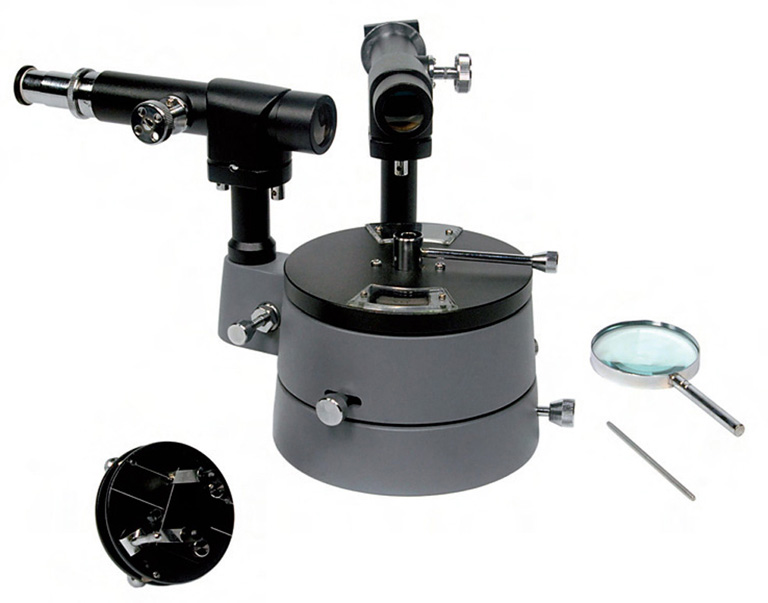 Click to Enlarge
Click to Enlarge
|
Spectrometer (0807)
Specifications : Size: 44 x 30 x 30 cm in wooden box – Weight: approx. 12 kg. Studying the spectral lines of a light source. The Spectrometer is used to study the spectral lines of a light source. Spectrometer allows you to detect the spectral lines with precision and to measure the corresponding wavelength. Easy to use and robust, this instrument is particularly suitable for classrooms. LAWS & PRINCIPLES INVESTIGATED : • Dispersion of light from a prism • Diffraction of light from a diffraction grating • Measurement of a dispersion power of a prism • Refraction index of a prism • Measurement of the diffraction power of a grating • Visualizing atomic spectra for different kind of lamps • Light emission by excitation of electrons • Measurement of the wavelength of the spectral lines • Quantum energy levels • Intensity of a spectral line
See Enlarge
|
|
|
|
 Click to Enlarge
Click to Enlarge
|
Handheld Spectrometer (0808)
Specifications : Size: approx 28 x 22 cm, Weight: approx 100 g. A simple and affordable way to begin studying the spectral lines. Handheld Spectrometer is the best solution to begin studying the spectral lines of a light source. With this instrument every single student could explore spectrometry by his own. Altay’s Handheld Spectrometer allows to detect the spectral lines with precision. LAWS & PRINCIPLES INVESTIGATED : • Light from excited energy levels • Monochromatic light.
See Enlarge
|
|
|
|
 Click to Enlarge
Click to Enlarge
|
Wimshurst Machine (0809)
Specifications : Size: 40 x 24 x 43 cm – Weight: approx. 4.4 kg. One of the classic electrostatic generator experiment. The Wimshurst Machine is an electrical generator with a distinctive appearance. With its two large contra-rotating disks mounted in a vertical plane and a spark gap within two metal spheres, the Wimshurst Machine is a historical electrostatic machine used for generating high voltages. Constructed according to the
classical model, this generator is safe to use and robustly built. Structural elements are in cast metal, with all insulating components constructed
from high dielectric strength plastic. Particular attention has been paid to the collection combs and supports so as to prevent damage to the radial
aluminium strips. LAWS & PRINCIPLES INVESTIGATED : • Electrostatic charge • Electrical sparks.
See Enlarge
|
|
|
|







